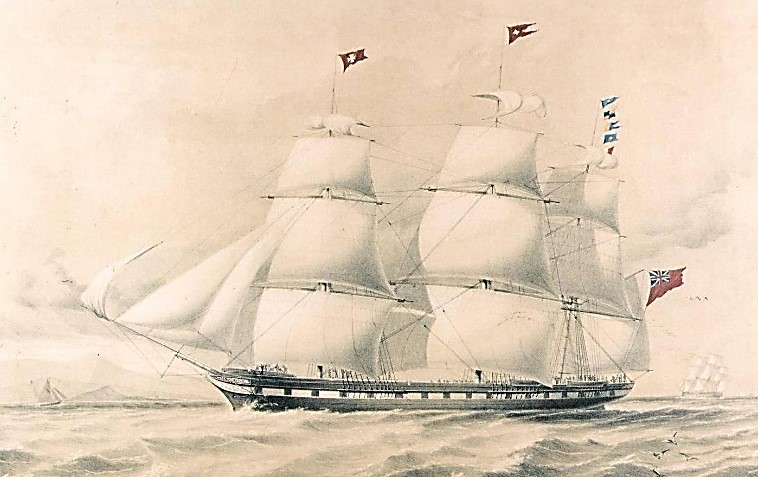The Founders of the WSL
Henry Threlfall Wilson and John Pilkington became established as shipbrokers in 1845. They charted their first ship, the barque Elizabeth in February 1846. As the partnership prospered, they purchased their own ship the Iowa. In June 1849, advertising started for the White Star Line of Boston Packets voyages.
In 1851, gold was discovered in Australia. The two partners saw potential profit in taking prospectors from England to Australia. The Bhurtpoor was intended to be the first ship to passage the prospectors. Unfortunately, she was wrecked off the coast of Ireland, near Wexford. The Ellen took her place on 23 July 1852.

The partners expanded and charted a full rigged ship, the Tayleur. She left Liverpool on Thursday, 19 January 1854, but did not finish her maiden voyage. There was a terrible storm and heavy seas pounded the ship and at 11:30 a.m. on 20 January 1854, the Tayleur crashed into Lambay Island, north-east of Dublin. The passengers found it difficult to get to safety and only 280 people survived out of the 650 on board.
The first ship officially registered to the White Star Line (WSL) was the clipper ship Red Jacket on 24 April 1854. It was one of the largest and fastest ships afloat. She was named after Sagoyewatha, a famous Seneca Indian chief, called “Red Jacket” by settlers. The ship’s figurehead was a carving of a North American Indian wearing a red jacket with a large five pointed white star on the breast.
The WSL adopted the emblem for their flag.
Thomas Ismay and Tomlinson and Co
In 1854, Thomas Henry Ismay began an apprenticeship with the shipbroking firm Imrie, Tomlinson and Co, of Liverpool. He became firm friends with William Imrie, the son of one of the partners in the firm. They would play a major role in the development of the WSL in preceding years.
In 1863, the Royal Standard was purchased. Pilkington had left the company and replaced by James Chambers, Henry Wilson’s brother-in-law. The Royal Standard’s maiden voyage from Liverpool to Melbourne via the Cape of Good Hope took place on 23 November 1863. Captain JE Allen died during the voyage. On 4 April 1864, the Royal Standard struck an iceberg with a glancing blow. She survived and was repaired at Rio de Janeiro, Brazil.
In December 1863, James Chambers resigned from his partnership. He felt that Wilson had gone too far in guaranteeing under penalty that the WSL ships would make the voyage from Liverpool to Melbourne in 68 days.
It could be argued that speed was put before safety and if something went wrong, the partners would all be liable, something Chambers was concerned about. Speed is of the essence in maintaining supremacy of shipping routes. Passengers prefer quicker voyages. Whichever line could boast the fastest ships on the Australian route, would attract the highest number of passengers.
In 1865, Wilson took another partner, John Cunningham. Trying to maximize profits from the gold rush and recognizing the high demand for passage to Australia, they expanded their fleet with the aid of loans.
In 1867, they defaulted on a loan of £527,000 by the Royal Bank of Liverpool which forced them into liquidation in 1869. Thomas Henry Ismay bought the name, flags and goodwill of the WSL for £1000. His ambition was to own the largest fleet of steamships serving the North Atlantic trade.
Thomas Ismay was married to Margaret Bruce. They had six children; their oldest son was Joseph Bruce Ismay who was born on 12 December 1862.
On 1 January 1891, both Joseph Bruce Ismay and his younger brother James Ismay were made partners in the firm of Ismay, Imrie and Company. Thomas Ismay retired from the firm in 1892 but remained the company chairman and still active part in the activities of the WSL.
T.H. Ismay & Company
Thomas Ismay was also in the shipping business. In 1859, he had taken on Philip Nelson as his business partner and formed Nelson, Ismay & Co. Nelson already owned a small ship, the Angelita which was used for their new business. Ismay proved too radical for Nelson. When Nelson retired in 1862, Ismay changed the company name to T.H. Ismay & Co.
Gustavus Schwabe was a Liverpool financier and Ismay needed his help in order to finance his fleet. Schwabe’s nephew was Gustav Wilhelm Wolff, a junior partner in the Belfast shipbuilding company, Harland and Wolff. Schwabe realised that if Ismay agreed to Harland and Wolff producing all of the WSL ships there would be a continuous stream of revenue for the shipbuilders and great for his nephew. If Ismay was to agree to this, Schwabe would finance him. An agreement was reached. All the ships were to be produced and built at the Belfast yard. A cost plus profit basis was adopted so that the builders constructed the very best ships possible.
On 6 September 1869, Ismay formed the Oceanic Steam Navigation Company to operate the steamers under construction. The company was registered and had capital of £400,000 in £1000 shares. Thomas Ismay had 50 shares and Schwabe had 12 shares. When the first ship was commissioned, Edward J Harland and Gustav Wolff became shareholders. Ismay and Imrie (his old friend from his apprentice days) decided they would form a partnership. When Imrie’s father died in 1870, Imrie, Tomlinson and Co was absorbed into the T.H. Ismay & Co which on enlargement was renamed Ismay, Imrie and Company, the parent company of the Oceanic Steam Navigation Company Ltd (the WSL’s official name).
